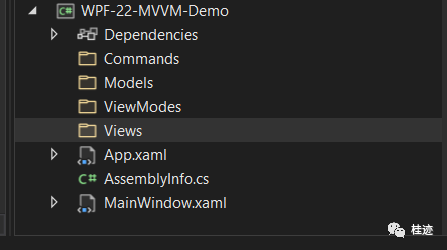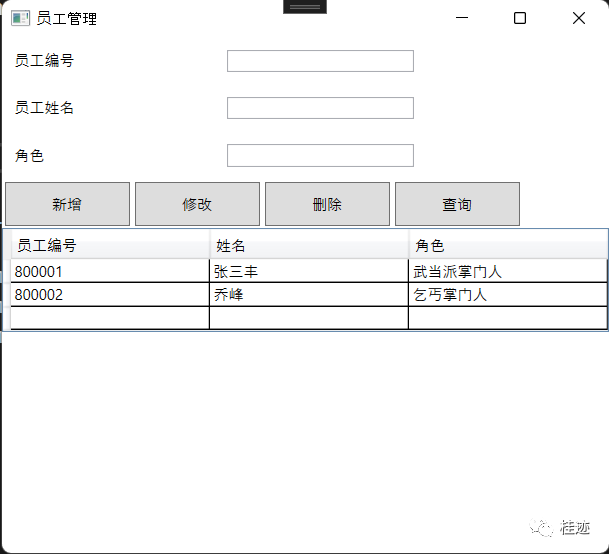
我们在Models文件下创建Employee类并让该类实现INotifyPropertyChanged接口,该类中定义编号、姓名和角色三个基本属性.
using System;using System.ComponentModel;using System.Runtime.CompilerServices;namespace WPF_22_MVVM_Demo.Models{public class Employee : INotifyPropertyChanged{private string no = String.Empty;public string No{get{return no;}set{if (value != this.no){no = value;NotifyPropertyChanged();}}}private string name = String.Empty;public string Name{get{return name;}set{if (value != this.name){this.name = value;NotifyPropertyChanged();}}}private string role = String.Empty;public string Role{get{return role;}set{if (value != this.role){this.role = value;NotifyPropertyChanged();}}}public event PropertyChangedEventHandler? PropertyChanged;private void NotifyPropertyChanged([CallerMemberName] String propertyName = ""){PropertyChanged?.Invoke(this, new PropertyChangedEventArgs(propertyName));}}}
在Models文件下定义服务EmployeeService,该类可以包含一些常用业务操作,例如:对远程api调用操作远程数据库以及本地数据库操作等,在该例子中,我们对一个内存对象集合实现增删改查操作
using System.Collections.Generic;using System.Linq;namespace WPF_22_MVVM_Demo.Models{public class EmployeeService{private static List<Employee> _employees = null!;public EmployeeService(){_employees = new List<Employee>(){new Employee(){No="800001",Name="张三丰",Role="武当派掌门人"},new Employee(){No="800002",Name="乔峰",Role="乞丐掌门人"},};}public List<Employee> GetEmployees(){return _employees;}}}
在Commands文件夹下定义DelegateCommand
using System;using System.Windows.Input;namespace WPF_22_MVVM_Demo.Commands{public class DelegateCommand : ICommand{private Action _execute;private Func<bool> _canExecute;public DelegateCommand(Action executeMethod){_execute = executeMethod;}public DelegateCommand(Action executeMethod, Func<bool> canExecute): this(executeMethod){this._canExecute = canExecute;}public event EventHandler CanExecuteChanged;public bool CanExecute(object parameter){return true;}public void Execute(object parameter){_execute();}}}
using System;using System.Collections.ObjectModel;using System.ComponentModel;using System.Runtime.CompilerServices;using System.Windows.Input;using WPF_22_MVVM_Demo.Commands;using WPF_22_MVVM_Demo.Models;namespace WPF_22_MVVM_Demo.ViewModes{public class EmployeeViewMode : INotifyPropertyChanged{public event PropertyChangedEventHandler? PropertyChanged;private void NotifyPropertyChanged([CallerMemberName] String propertyName = ""){PropertyChanged?.Invoke(this, new PropertyChangedEventArgs(propertyName));}EmployeeService employeeService;public EmployeeViewMode(){employeeService = new EmployeeService();BindData();Employee = new Employee();}private Employee employee;public Employee Employee{get { return employee; }set { employee = value;NotifyPropertyChanged(); }}private ObservableCollection<Employee> employeeList;public ObservableCollection<Employee> EmployeeList{get{return employeeList;}set{employeeList = value;NotifyPropertyChanged();}}/// <summary>///消息提示/// </summary>public string Message{get;set;}/// <summary>/// DataGrid绑定数据/// </summary>public void BindData(){EmployeeList = new ObservableCollection<Employee>(employeeService.GetEmployees());}}}
在Views文件加下创建EmployeeView.xaml,将窗体的DataContext指向EmployeeViewMode,在该界面有两部分组成:
-
录入信息,将文本框和EmployeeViewMode中的Employee对象的属性做绑定 -
DataGrid展示数据列表,将控件的ItemsSource属性绑定EmployeeViewMode对象中的EmployeeList属性
<UserControl x:Class="WPF_22_MVVM_Demo.Views.EmployeeView"xmlns="http://schemas.microsoft.com/winfx/2006/xaml/presentation"xmlns:x="http://schemas.microsoft.com/winfx/2006/xaml"xmlns:mc="http://schemas.openxmlformats.org/markup-compatibility/2006"xmlns:d="http://schemas.microsoft.com/expression/blend/2008"mc:Ignorable="d"><Grid><Grid.RowDefinitions><RowDefinition Height="0.1*"></RowDefinition><RowDefinition Height="0.1*"></RowDefinition><RowDefinition Height="0.1*"></RowDefinition><RowDefinition Height="0.1*"></RowDefinition><RowDefinition Height="0.6*"></RowDefinition></Grid.RowDefinitions><Grid.ColumnDefinitions><ColumnDefinition Width="0.35*"></ColumnDefinition><ColumnDefinition Width="0.65*"></ColumnDefinition></Grid.ColumnDefinitions><TextBlock Grid.Row="0" Grid.Column="0" Margin="10">员工编号</TextBlock><TextBox Grid.Row="0" Grid.Column="1" Text="{Binding Path=Employee.No}" Width="150" HorizontalAlignment="Left" Margin="10"/><TextBlock Grid.Row="1" Grid.Column="0" Margin="10">员工姓名</TextBlock><TextBox Grid.Row="1" Grid.Column="1" Text="{Binding Path=Employee.Name}" Width="150" HorizontalAlignment="Left" Margin="10"></TextBox><TextBlock Grid.Row="2" Grid.Column="0" Margin="10">角色</TextBlock><TextBox Grid.Row="2" Grid.Column="1" Text="{Binding Path=Employee.Role}" Width="150" HorizontalAlignment="Left" Margin="10"></TextBox><StackPanel Grid.Row="3" Grid.ColumnSpan="2" Orientation="Horizontal" HorizontalAlignment="Left" VerticalAlignment="Top"><Grid><Grid.RowDefinitions><RowDefinition></RowDefinition></Grid.RowDefinitions><Grid.ColumnDefinitions><ColumnDefinition></ColumnDefinition><ColumnDefinition></ColumnDefinition><ColumnDefinition></ColumnDefinition><ColumnDefinition></ColumnDefinition></Grid.ColumnDefinitions></Grid><Button Content="新增" Width="100" Height="30" Margin="2"></Button><Button Content="修改" Width="100" Height="30" Margin="2"></Button><Button Content="删除" Width="100" Height="30" Margin="2"></Button><Button Content="查询" Width="100" Height="30" Margin="2"></Button></StackPanel><DataGrid Grid.Row="4" Grid.ColumnSpan="2" Name="empGrid" AutoGenerateColumns="False" ItemsSource="{Binding Path=EmployeeList,Mode=TwoWay,UpdateSourceTrigger=PropertyChanged}"><DataGrid.Columns><DataGridTextColumn Header="员工编号" Width="0.3*" Binding="{Binding Path=No,Mode=TwoWay,UpdateSourceTrigger=PropertyChanged}"></DataGridTextColumn><DataGridTextColumn Header="姓名" Width="0.3*" Binding="{Binding Path=Name,Mode=TwoWay,UpdateSourceTrigger=PropertyChanged}"></DataGridTextColumn><DataGridTextColumn Header="角色" Width="0.3*" Binding="{Binding Path=Role,Mode=TwoWay,UpdateSourceTrigger=PropertyChanged}"></DataGridTextColumn></DataGrid.Columns></DataGrid></Grid></UserControl>
using System.Windows.Controls;using WPF_22_MVVM_Demo.ViewModes;namespace WPF_22_MVVM_Demo.Views{/// <summary>/// Interaction logic for EmployeeView.xaml/// </summary>public partial class EmployeeView : UserControl{public EmployeeView(){InitializeComponent();this.DataContext = new EmployeeViewMode();}}}
在MainWindow.xaml窗体中引用EmployeeView
<Window x:Class="WPF_22_MVVM_Demo.MainWindow"xmlns="http://schemas.microsoft.com/winfx/2006/xaml/presentation"xmlns:d="http://schemas.microsoft.com/expression/blend/2008"xmlns:x="http://schemas.microsoft.com/winfx/2006/xaml"xmlns:mc="http://schemas.openxmlformats.org/markup-compatibility/2006"xmlns:EmpView="clr-namespace:WPF_22_MVVM_Demo.Views"mc:Ignorable="d"Title="员工管理" Height="450" Width="500"><StackPanel><EmpView:EmployeeView></EmpView:EmployeeView></StackPanel></Window>
运行如下:

